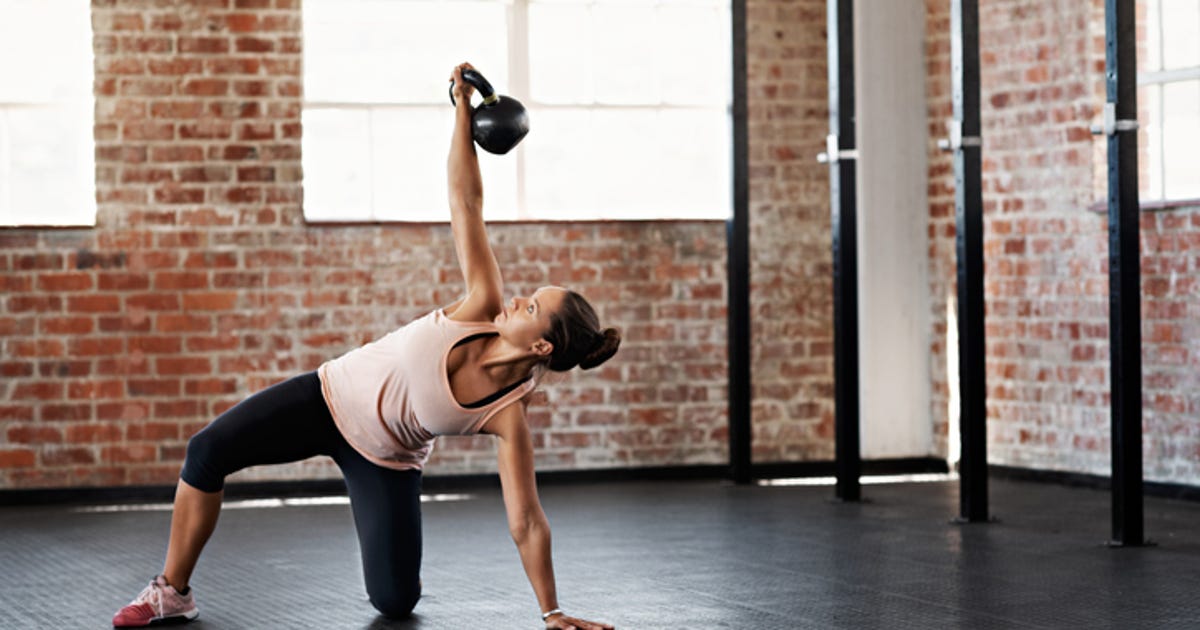A kettlebell is a versatile piece of equipment used to train for endurance, power and strength. Kettlebells are one of the best exercise tools suitable for everyone — beginners, experienced lifters and people of all ages. They’re made of cast iron and shaped like a cannonball with a flat bottom and a handle (also known as a horn) on top. “The horns extended above the bell makes it great for teaching the hinge patterning and deadlifts in older folks, whereas a dumbbell would require too much depth and range of motion,” said the founder of the Ladder app, Lauren Kanski, who is also a Body and Bell coach, fitness adviser for Women’s Health magazine and a certified personal trainer with the National Academy of Sports Medicine.
If you’re new to kettlebell training, it’s helpful to seek a kettlebell coach who can teach you proper techniques as well as the different types of kettlebell training styles. For example, hard-style training uses max force in every rep with heavy weights, whereas sports-style training has more of a flow and uses lighter weights to easily transition from one movement to another.
It’s also helpful for rehab exercises because of the way the kettlebell functions when it’s in use. “We can increase acceleration and force without having to increase the load, which makes it easier on the joints,” said Kanski. “The way the horns are shaped and if we hold it in the rack position or overhead, makes it great for wrist, elbow and shoulder health, as well.”
Since many kettlebells can cause irritation on the back of the wrist, the brand manufacturer matters. “I recommend a single cast kettlebell with a powder finish made by brands such as Rogue and Kettlebell Kings because they’re expensive but they’ll last a lifetime,” Kanski said. Although you don’t necessarily need to use kettlebells with a powder finish, keep in mind that other materials may feel more slippery.
If you’re ready to take on kettlebells, there are plenty of exercises you can start off with and progress to once you’ve mastered the technique. We recommend seeking guidance from an expert to make sure you’re doing these movements safely and correctly before you do them on your own. Kanski says one of the best ways to learn how to use a kettlebell is to follow a program since it takes a lot of practice. Below are some of the best kettlebell exercises you can add to your fitness regimen, whether you’re a novice or an experienced lifter.
Kettlebell deadlift
The kettlebell deadlift is a foundational movement that is important to master first. The kettlebell deadlift targets your posterior chain, which includes lower body muscles like your glutes, hamstrings, quadriceps and even your upper body muscles like your back, erector spinae, deltoids and trapezius. Kanski says the majority of exercises you do with a kettlebell derive from the deadlift. Choose a weight you’re comfortable with that allows you to do eight reps for a few sets.
Standing with your feet hip-width apart, place a kettlebell in between your feet with the handle in line with the arches of your feet. Engage your core, softening your knees and hinging at the hips (imagine tapping your butt to the wall). Grip the kettlebell on each side of the handle and roll your shoulders back and down so your lat muscles are packed in and away from your ears. Externally rotate your arms so it feels like you’re trying to break the handle in half on each side. As you come up to standing, imagine you’re pushing the floor away with your feet. Repeat.
Single-arm kettlebell clean
The kettlebell clean is another important exercise because it’s the safest way to bring the kettlebell into a rack position or to carry it in front of the body. The kettlebell clean works your lower body muscles, which include your glutes, hamstrings, quadriceps, hip flexors as well as your whole core. The upper body muscles targeted include your shoulders, triceps, biceps and upper back. To perform a kettlebell clean, you’ll need to stand with your feet hip-width apart. Envision creating a triangle with your body and foot placement. Place the kettlebell at least one foot in front of you and reach down as you hinge, grabbing the handle with one arm. Engage your core and pull your shoulders down and back as you hips to swing the bell underneath you and extend your hips forward as you rotate the hand and bring the arm up vertically and close to the body so the kettlebell ends up resting between your forearm, chest and bicep. Your wrist should remain straight or slightly flexed inward in this position.
Double-arm kettlebell swing
The kettlebell double-arm swing is the next exercise to learn after the deadlift and kettlebell clean. This exercise is a ballistic movement that’s good for strengthening your posterior chain (your back, glutes and hamstrings). To set up for a kettlebell swing, start with the kettlebell out in front of you at about arm’s length, with your palms over the horn of the bell. Instead of using one arm, you’re using both for this move. Slightly bend at the knees so you’re in a hinge position, reach for the kettlebell handle with a pronated grip and pull your shoulders back and down. Once your body is fully engaged, you’re going to pretend you’re breaking the handle in half and hike the kettlebell back, keep your butt down in the hike, then quickly snap your hips forward to bring your body into a standing position. This will propel your arms and the kettlebell to swing forward, which should only go up to shoulder height, floating momentarily before it swings back down as you push your hips back with a slight bend in your knees.
Single-arm kettlebell overhead press
The kettlebell overhead press works your upper body, chest and core muscles. It also requires decent shoulder mobility to make sure you can safely press the heavy weight overhead. These are some helpful ways to test your range of motion. If you’ve established that you can do this exercise, you’ll first need to do a single-arm kettlebell clean to have the bell in a rack position. From the rack position, focus on having a strong stance by pulling your shoulder blades back and squeezed together as you press up. When you press overhead, your knuckles should be pointed toward the ceiling and your wrist, elbow and shoulder should be in one straight line.
Single-arm kettlebell push press
The push press is similar to the overhead press, except it includes some movement from your lower body to help bring the kettlebell overhead. The kettlebell push press targets your shoulders, lats, traps, upper pectoral muscles and triceps. To do a push press, you’ll need to perform a single-arm kettlebell clean first. Holding the kettlebell in the rack position, your knees should be slightly bent. Then using slight momentum from your lower body, push your hips forward to explode your body straight up, driving the kettlebell above your head.
Single-arm kettlebell swings
Once you’ve mastered the double-arm kettlebell swing, you can start practicing single-arm kettlebell swings. Follow the same setup instructions for the double kettlebell swing for this exercise. The difference is that the free arm tracks the working arm through the movement so it flows smoothly. This move is challenging because you’re using more of your stabilizing muscle to avoid rotating your body.
Single-arm kettlebell snatch
The kettlebell single-arm snatch is an advanced kettlebell exercise that requires good shoulder stability since it’s a ballistic movement with the kettlebell going overhead. It’s also one of the most technical exercises, which is why it’s important to be able to do a swing, clean and press proficiently first. This exercise relies on both the lower and upper body to generate the power necessary to execute it. It works your glutes, hips, hamstrings and all of your mid and upper back muscles. This full-body exercise looks similar to a kettlebell swing, except you aren’t using the power generated to swing horizontally — you’ll use it to bring the bell up vertically or overhead in a swift movement.
To do the single-arm snatch, start out with the kettlebell in front of you and set yourself up the same way you would for a kettlebell swing. As you hike the kettlebell back and bring your hips forward, pull the kettlebell close to your ribcage at a 90-degree angle and let the arm float the kettlebell vertically, then punch up to finish the movement overhead. The kettlebell should be resting on the back of your forearm with a strong wrist and palms facing forward. It may take some practice, but it’s important to avoid banging your wrist at the top. Instead, the kettlebell should feel light at this point.
Double kettlebell swings
As you become better versed with kettlebells, you can move on to more advanced movements of the same exercise. Double kettlebell swings use two kettlebells and the same technique as double-arm or single-arm kettlebell swings. You can play around with your stance and stand wider if the kettlebells are on the bigger side.
Double kettlebell cleans
Double kettlebell cleans are similar to the other kettlebell clean variations. The difference is you can widen or narrow your stance, depending on the size of the kettlebells you’re using. Make sure to keep your elbows locked in by your ribcage as you snap your hips forward to clean the kettlebells up at the same time.
Double kettlebell snatches
As previously mentioned, the kettlebell snatch is an advanced movement because of how important it is to get the technique right. If you’ve mastered the kettlebell snatch without limited mobility on your right or left shoulder, then you might be ready for double kettlebell snatches. To do double kettlebell snatches, you’ll need to follow the same setup as a single-arm kettlebell snatch. The difference is that you’re maneuvering two kettlebells, instead of one. This can get tricky because upon swinging, you’ll need to vertically punch up both kettlebells at the exact same time.
The information contained in this article is for educational and informational purposes only and is not intended as health or medical advice. Always consult a physician or other qualified health provider regarding any questions you may have about a medical condition or health objectives.
#Kettlebell #Workouts #Fit






